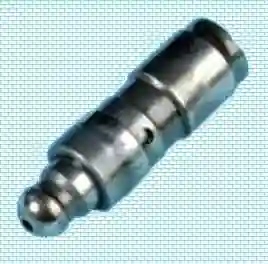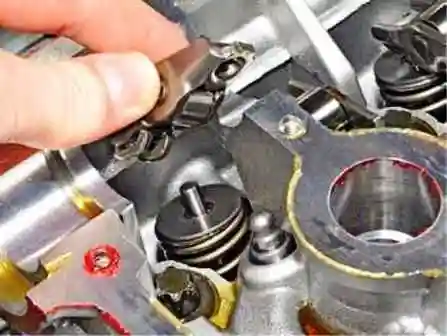The hydraulic gap compensators in the valve drive mechanism of the K4M engine are used to compensate for thermal expansion of the drive elements.
The operation of the hydraulic compensator is based on the principle of incompressibility of engine oil, which constantly fills the internal cavity of the hydraulic compensator during engine operation and moves its plunger when a gap appears in the valve drive, ensuring constant contact of the valve drive pressure lever roller with the camshaft cam without gap.
This eliminates the need for valve adjustment during maintenance.

Hydraulic lifters are non-separable compact devices inserted into the sockets of the cylinder head.
Valve knocking of a running engine can be caused by:
- - air ingress into the over-plunger cavities of hydraulic compensators when the oil level in the crankcase is too low or too high, as well as when the car is parked on a slope for a long time;
- - contamination of the precision surfaces of the hydraulic clearance compensators in the valve drive mechanism with sludge from low-quality engine oil (or if it is not replaced in time, as well as if the oil filter is damaged);
- - wear of hydraulic compensators.
If pumping or flushing fails to restore the hydraulic compensators, replace them, as their design is non-separable.
Initially, make sure that extraneous noise during engine operation is caused by a malfunction of the hydraulic lifters:
- start the engine.
If the hydraulic compensators fail, extraneous noise in the head cover area appears immediately after the engine is started and changes in accordance with the change in engine speed.
If the noise does not appear immediately after starting the engine or does not change when the crankshaft speed changes, the malfunction is not caused by a malfunction of the hydraulic lifters.
Moreover, if the noise does not change with the change in the speed of the crankshaft, the cause of extraneous noise is probably not in the engine;
- when the engine is idling, make sure that the noise level does not change when the load changes (for example, when switching the automatic transmission selector from position N to position D when disengaging the clutch of a car with a manual transmission or when turning on electrical consumers and air conditioning) .
If the noise level changes, the cause may be a collision of parts due to wear of the connecting rod and main bearings of the crankshaft, and not a malfunction of the hydraulic lifters;
- warm up the engine to operating temperature.
If the noise has decreased or disappeared, the rattling of the hydraulic lifters may be caused by oil contamination. In this case, it is necessary to flush the hydraulic lifters.
- if the noise does not disappear, it is likely that air has entered the hydraulic lifters, and it should be removed.
If the oil level in the crankcase is too low, the oil pump will entrain air along with the oil; if the oil level in the crankcase is too high, the oil is agitated and foamed by the counterweights of the crankshaft.
When the car is parked on a slope for a long time, oil flows out of the cavities of the hydraulic compensators and oil channels, and the supply of oil to the hydraulic compensators after starting the engine takes some time, during which the cavity of the hydraulic compensator has time to get air.
In all these cases, when oil with air enters the over-plunger cavity of the hydraulic compensator, the air inside the cavity when the valve is opened will be compressed and the hydraulic compensator will not be compressed, which will lead to a characteristic knock of the valve mechanism with increased clearances.
To bleed air from the hydraulic lifters, do the following:
Check the oil level in the crankcase and top up if necessary;
- - start the engine and warm it up at idle for 1 - 3 minutes;
- - increase the crankshaft speed to 3000 min-1, then sharply reduce to idle speed and let the engine idle;
- - repeat the cycle and check if the noise of the valve drive mechanism has disappeared.
If the hydraulic lifters are in good condition, the noise disappears after 10 - 30 cycles;
- - after the noise disappears, repeat to remove air five more times;
- - let the engine idle for 1-3 minutes and make sure that the noise of the valve drive mechanism has disappeared.
If the noise of the valve drive mechanism does not disappear after bleeding and warming up the engine to operating temperature, identify faulty hydraulic lifters as follows.
Stop the engine and immediately after stopping the Move the piston of the 1st cylinder to the TDC position of the compression stroke, remove the cylinder head cover.
Remove the camshafts.
To check the performance of the engine hydraulic compensators, press the shoulder of the rocker arm resting on the hydraulic compensator.
If the rocker arm can be moved with little or no effort, the hydraulic lifter is faulty.
Similarly, check the condition of the hydraulic compensators of the remaining cylinders (the order of operation of cylinders 1-3-4-2).
After identifying faulty hydraulic lifters, you should first try to flush them as follows.
Remove the air filter (article - How to replace the Renault Sandero engine air filter element)
Remove the cylinder head cover (article - Replacing the Renault Sandero cylinder head cover gasket)
Remove the camshaft from the side of the hydraulic compensator to be replaced

Remove the valve push lever

Removing the faulty hydraulic compensator
We prepare three containers for flushing hydraulic lifters (you can use cut plastic canisters).
The size of each container must be sufficient so that the hydraulic compensator, lowered to the bottom of the container in a vertical position, is completely immersed in the liquid.
Fill the containers with clean diesel fuel.
It is advisable to mark the containers.
We use the first container for preliminary flushing of the hydraulic compensator, the second for the final flush, and the third for filling the hydraulic compensators.
We place the hydraulic compensator in the first container and clean the outer surface.
Having immersed the hydraulic compensator in the first container halfway with the plunger down, lightly pressing the wire through the hole, squeeze the valve ball and, holding the ball depressed, move the hydraulic compensator plunger 5-10 times until the plunger moves completely free.
If the plunger does not move easily, replace the hydraulic compensator.
Remove the hydraulic compensator from the tank and, having squeezed the valve ball, move the plunger until the diesel fuel completely flows out of the hydraulic compensator.
Place the hydraulic compensator in the second container and repeat operation 7.
remove the hydraulic compensator from the tank and drain the diesel fuel from it, as described in operation 8.
We place the hydraulic compensator on the bottom of the third container vertically with the plunger up and squeeze the ball of its valve with a wire.
While holding the valve ball depressed, move the plunger down and then slowly move it up so that the over-plunger cavity of the hydraulic compensator is filled with diesel fuel.
We take the hydraulic compensator out of the tank, holding it with the plunger up, press the plunger with a little effort and make sure that it remains motionless.
At the same time, we check the overall height of the hydraulic lifter by comparing it with the new hydraulic lifter.
If during the check it was possible to move the hydraulic compensator plunger, repeat steps 12 and 13 until the hydraulic compensator cavity is completely filled with diesel fuel.
If after that the hydraulic compensator does not reach working condition, then we replace it.
Before assembling the valve actuator, store filled hydraulic lifters only in the vertical position, with the plungers up. Avoid getting dirt into the hydraulic lifters.
Install filled hydraulic lifters as soon as possible to avoid possible loss of diesel fuel.
After that, install and assemble the parts in reverse order.
Start the engine, let it idle for 1-3 minutes.
If necessary, remove air from the hydraulic lifters.





